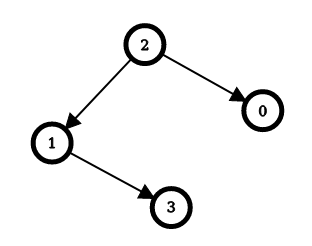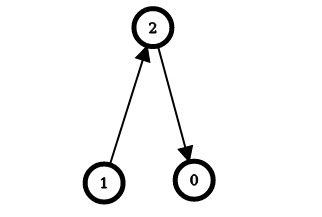LeetCode in Kotlin
2858. Minimum Edge Reversals So Every Node Is Reachable
Hard
There is a simple directed graph with n nodes labeled from 0 to n - 1. The graph would form a tree if its edges were bi-directional.
You are given an integer n and a 2D integer array edges, where edges[i] = [ui, vi] represents a directed edge going from node ui to node vi.
An edge reversal changes the direction of an edge, i.e., a directed edge going from node ui to node vi becomes a directed edge going from node vi to node ui.
For every node i in the range [0, n - 1], your task is to independently calculate the minimum number of edge reversals required so it is possible to reach any other node starting from node i through a sequence of directed edges.
Return an integer array answer, where answer[i] is the minimum number of edge reversals required so it is possible to reach any other node starting from node i through a sequence of directed edges.
Example 1:

Input: n = 4, edges = [[2,0],[2,1],[1,3]]
Output: [1,1,0,2]
Explanation: The image above shows the graph formed by the edges.
For node 0: after reversing the edge [2,0], it is possible to reach any other node starting from node 0.
So, answer[0] = 1.
For node 1: after reversing the edge [2,1], it is possible to reach any other node starting from node 1.
So, answer[1] = 1.
For node 2: it is already possible to reach any other node starting from node 2.
So, answer[2] = 0.
For node 3: after reversing the edges [1,3] and [2,1], it is possible to reach any other node starting from node 3.
So, answer[3] = 2.
Example 2:

Input: n = 3, edges = [[1,2],[2,0]]
Output: [2,0,1]
Explanation: The image above shows the graph formed by the edges.
For node 0: after reversing the edges [2,0] and [1,2], it is possible to reach any other node starting from node 0.
So, answer[0] = 2.
For node 1: it is already possible to reach any other node starting from node 1.
So, answer[1] = 0.
For node 2: after reversing the edge [1, 2], it is possible to reach any other node starting from node 2.
So, answer[2] = 1.
Constraints:
2 <= n <= 105edges.length == n - 1edges[i].length == 20 <= ui == edges[i][0] < n0 <= vi == edges[i][1] < nui != vi- The input is generated such that if the edges were bi-directional, the graph would be a tree.
Solution
import java.util.LinkedList
import java.util.Queue
class Solution {
fun minEdgeReversals(n: Int, edges: Array<IntArray>): IntArray {
val nexts: Array<MutableList<IntArray>> = Array(n) { ArrayList() }
for (edge in edges) {
val u = edge[0]
val v = edge[1]
nexts[u].add(intArrayOf(1, v))
nexts[v].add(intArrayOf(-1, u))
}
val res = IntArray(n)
for (i in 0 until n) {
res[i] = -1
}
res[0] = dfs(nexts, 0, -1)
val queue: Queue<Int> = LinkedList()
queue.add(0)
while (queue.isNotEmpty()) {
val index = queue.remove()
val `val` = res[index]
val next: List<IntArray> = nexts[index]
for (node in next) {
if (res[node[1]] == -1) {
if (node[0] == 1) {
res[node[1]] = `val` + 1
} else {
res[node[1]] = `val` - 1
}
queue.add(node[1])
}
}
}
return res
}
private fun dfs(nexts: Array<MutableList<IntArray>>, index: Int, pre: Int): Int {
var res = 0
val next: List<IntArray> = nexts[index]
for (node in next) {
if (node[1] != pre) {
if (node[0] == -1) {
res++
}
res += dfs(nexts, node[1], index)
}
}
return res
}
}

